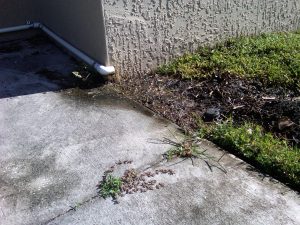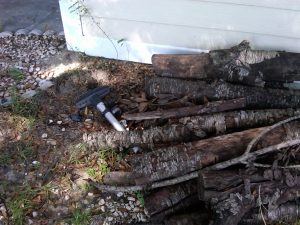If termites are blind and shun light just how do they find their way into your home? I mean they live under ground and can’t follow already made pathways but actually have to make tunnels in which to move. Soil particle by soil particle they span out and as if by random and they still find wood to eat. Wood has no odor that attracts them (termites don’t have a nose either) but still homes across America get infested with termites every year to the tune of billions of dollars in treatment and repair costs.
There is some research going on right now that suggests termite foraging is not so random and is in fact quite deliberate. While that has yet to come to a full conclusion I can tell you that there are three main reasons that termites will latch onto a structure and blindly or not they’ll search out and eat every fiber of wood they can get their teeth into.
Moisture
Regardless of the limitation of sight there is one prime ingredient that will not only allow termites more foraging time near the dryer air at

a/c drip line not routed properly
This is why when a search party of termites find a ready made source of water they make full use of it and that area may be searched out far more than say an area of dryer soils. As homeowners we unwittingly supply termites with oasis’s just like this and give them every reason to find a way into our home. Leaky gutters, dripping spigots or hoses are very obvious and easy fixes but often go unchecked. Sprinklers improperly aimed or over watering of shrubs or poor landscaping and drainage can all contribute but the #1 supplier of moisture I find is the a/c drip line. While the items listed above don’t help they are usually not an everyday thing because sprinklers might be set for 3 times per week and gutters need rain to leak. Leaky spigots can be constant and that’s not good but not every home has this. All homes have air conditioners and during the summer the a/c kicks on many times a day. Each time it does it creates water in the air handling unit and that h2o is funneled outside via pvc pipe. The flow is sometimes substantial but more importantly constant. Same place, close to the same amount and like I said many times per day. This area of discharge is almost always wet and doesn’t have time to dry in between the units down time. Once termites find this moisture source it is sure to be explored fully and this is why this area is one of the three most conducive conditions for termite invasion.
Wood to ground contact
The way to a termites heart is through its belly. Give him food and he’ll LOVE your home. For the same reasons termites search out moisture they’ll also exploit any wood to ground contact. The reason is that wood soaks up moisture and since they need that and get a free meal what’s not to like? It’s also easy to bridge the gap from their subterranean world to above ground as it provides a ready made defense for them as they move, eat and search right there in the protection of the wood. Wood to ground can take all sorts of forms. Deck posts buried in the soil, wood strips that separate expansion joints in sidewalks or patios, siding below grade or wood piles stored right next to and even touching the home. The most common thing

Wood pile and siding below grade
How can you fix this?
The remedies are simple and only the altering of siding may incur the use of a handyman or qualified person. Other than that it’s as easy as removing the wood or digging out the siding and you essentially take away that problem or entry point for the termite. I suggest putting the wood away from the home and storing it up off the ground for added security. Rocks instead of mulch and soil are much better near the home as it allows better drainage and makes spotting any termite activity that much easier.
For your a/c drip line you simply need to reroute the constant water source away from the home. By adding a small extension to the pvc pipe you can run this water almost anywhere. Many people take advantage of the ‘free’ water and run their pipe to a plant or tree where the water will be put to good use. Regardless of where it goes, AWAY FROM THE HOME is the ultimate goal.
These simple steps are no 100% guarantee that termites won’t strike your home but they are at least the easiest ways to eliminate the 3 most conducive ways termites invade.




